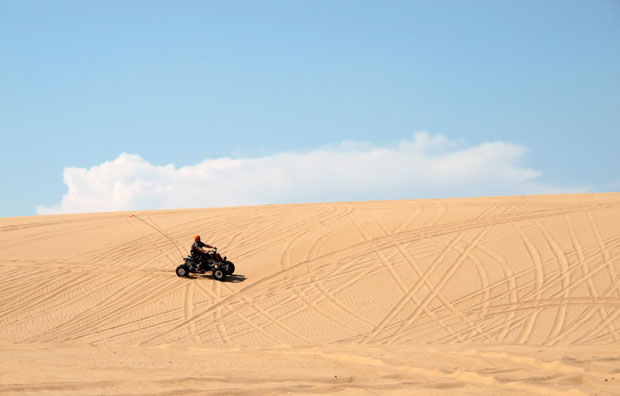
A man rides an ATV across the sand at Beaver Dunes, a former state park recently aquired by the City of Beaver.
Logan Layden / NPR STATEIMPACT


A man rides an ATV across the sand at Beaver Dunes, a former state park recently aquired by the City of Beaver.
Logan Layden / NPR STATEIMPACT
Oklahoma hasn’t shuttered a state park in nine years, and it’s been 20 years since we’ve seen the scope of parks closures announced in early 2011.
In March, the Oklahoma Tourism and Recreation Department said it would close seven state parks, reducing its park total to 35 from 42. The department’s Executive Director Deby Snodgrass said the move would save taxpayers about $660,000 per year.

Logan Layden / NPR STATEIMPACT
A man rides an ATV across the sand at Beaver Dunes, a former state park recently acquired by the City of Beaver.
The department has had its budget cut by more than 22 percent since 2009, and was anticipating its budget to shrink another 3 percent this year, Snodgrass said.
Six of the seven doomed parks were in eastern Oklahoma.
The parks — Adair, Boggy Depot, Heavener Runestone, Brushy Lake, Beaver Dunes, Wah-Sha-She and Lake Eucha — were among the 20 least-attended in 2011, according to tourism data.
While no longer considered state parks, none of the parks are actually closing. Cities assumed management of five of the parks; American Indian tribes took on the other two.
Oklahoma’s last park closure came in 2002, when the state handed the Quartz Mountain Resort Park/Golf Course over to the state’s Higher Education Board of Regents in a bill authored by late state Sen. Robert M. Kerr, D-Altus.
Kerr hoped reconfiguring the historically money-losing resort as an educational conference center would help it attract endowments and grants.
Scores of state-run parks, museums and historical sites were shut down in 1991, a dozen of which were transferred to the Oklahoma Historical Society. Operations at 14 other state-run sites were transferred or discontinued all together that year.

J. Stephen Conn / Flickr
A former state park, the Washita Battlefield near Cheyenne became a part of the National Parks System in 1996.
Beyond their poor attendance records, data show the parks slated for closure this year were among the 10 that generated the least revenue from activity fees, such as those levied for camping, hooking up RVs or using boat ramps.
All together, the seven former state parks only made $122,628 in FY 2011, less than 1 percent of total parks revenue, tourism data show.
Cities and tribes are just starting to account for the new parks in their budgets, so it’s unclear if the public will see any increases in fees associated with park activities. But some of the parks’ new owners are already discussing whether to cut back on park services and employees.
The City of Sallisaw, which recently acquired Brushy Lake, has reduced the park’s annual bill to about $70,000 from more than $231,000. But City Manager Bill Baker is already lamenting the loss of funding that could have been spent on other city salaries or equipment — like police cars.